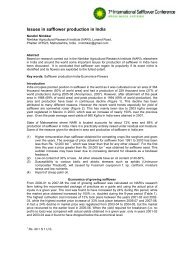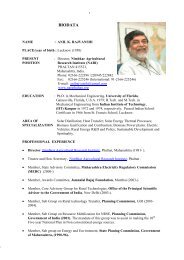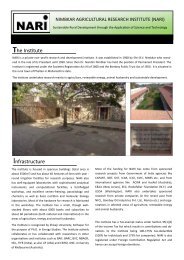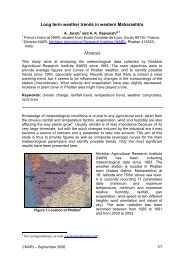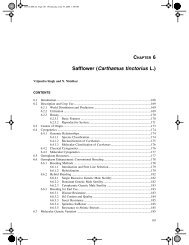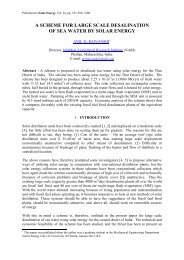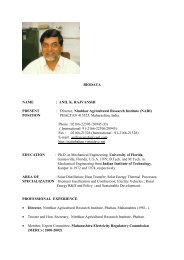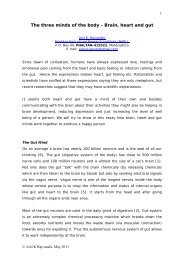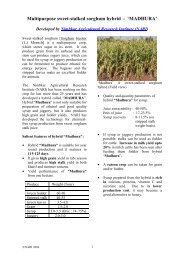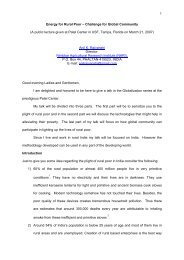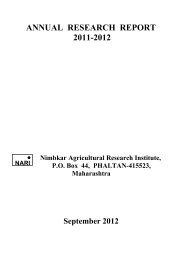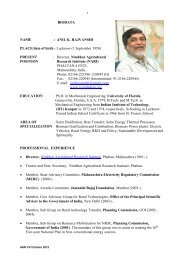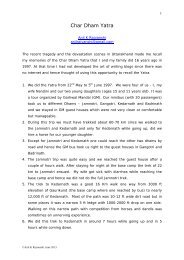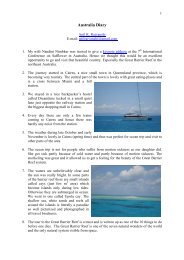You also want an ePaper? Increase the reach of your titles
YUMPU automatically turns print PDFs into web optimized ePapers that Google loves.
2Household cooking and lightingTechnology DevelopmentWith the help of his colleagues, Dr. <strong>Rajvanshi</strong> has carried out research in varied subject areas,which were selected based on perceived needs of local rural population in and aroundPhaltan.For example, during his early stay in 1980s at Phaltan (a rural town) the electricity situationwas not very good resulting in frequent blackouts. This made him start work on developingan improved and very efficient liquid fuel lantern. The designing of the lantern required verysophisticated tools of heat and mass transfer, combustion and fluid dynamics. This lanternchristened “NOORIE” is a multifuel one and runs on kerosene, diesel and low concentrationethanol. According to knowledgeable experts in the area of liquid fuel lighting, developmentof NOORIE lantern was the first major advancement since early 1920s in lantern technology.It is much more efficient than the existing available designs and is much easier to light.Besides, it also doubles as a small cooking stove. There is a good demand for Noorielanterns both internally and for exports.Recently the concept of Noorie lantern has been expanded into kerosene Lanstove. Thisdevice simultaneously provides excellent light and cooks a complete meal for a family offive. Lanstove is being extensively tested in rural huts around Phaltan. Working with ruralpoor during lanstove testing also showed that rural poor eat nutritionally very poor diet. Thisled Dr. <strong>Rajvanshi</strong> to develop a concept of rural restaurants which is being actively pursuedby various Government and International agencies as a viable way for improving the nutritionof rural poor.In developing kerosene lanterns, Dr. <strong>Rajvanshi</strong> became acutely aware of the need fordeveloping an alternative liquid fuel which should be renewable, environmentally sustainableand home-grown. Consequently, he and his team established the pioneering program forproduction of ethanol from sweet sorghum in middle 1980’s.Sweet sorghum is an excellent substitute to sugarcane for ethanol production. Besides it is amulti purpose crop and produces grain, sweet juice and excellent fodder simultaneously fromthe same piece of land. Per unit of water consumption it is also one of the most efficient sugarproducers. Dr. <strong>Rajvanshi</strong> and his group established in late 1980’s, probably one of thelargest multidisciplinary research programs in the world on sweet sorghum for ethanolproduction. It included extensive breeding for higher yielding varieties, fermentationstudies, solar distillation plant (a 50 l/day pilot plant running completely on solar energywas set up at <strong>NARI</strong> campus in 1987), and development of stoves and lanterns to work onlow concentration ethanol. These efforts resulted in making <strong>NARI</strong> the only Institute inIndia to be invited by European Economic Commission in 1993 to be a part of Europeannetwork in Sweet Sorghum Research and Development.As a result, <strong>NARI</strong>’s sweet sorghum hybrids have been tested and sown in about ninecountries viz. Mexico, Zambia, Thailand, Pakistan, Zimbabwe, Portugal, Mauritius, Franceand Italy. Besides the production of ethanol, Dr. <strong>Rajvanshi</strong> and his team also embarked uponthe development of complete technology for producing jaggery and syrup from sweetsorghum. The MADHURA sweet sorghum syrup has been successfully test-marketed. TillAKRbiodata June 2014



